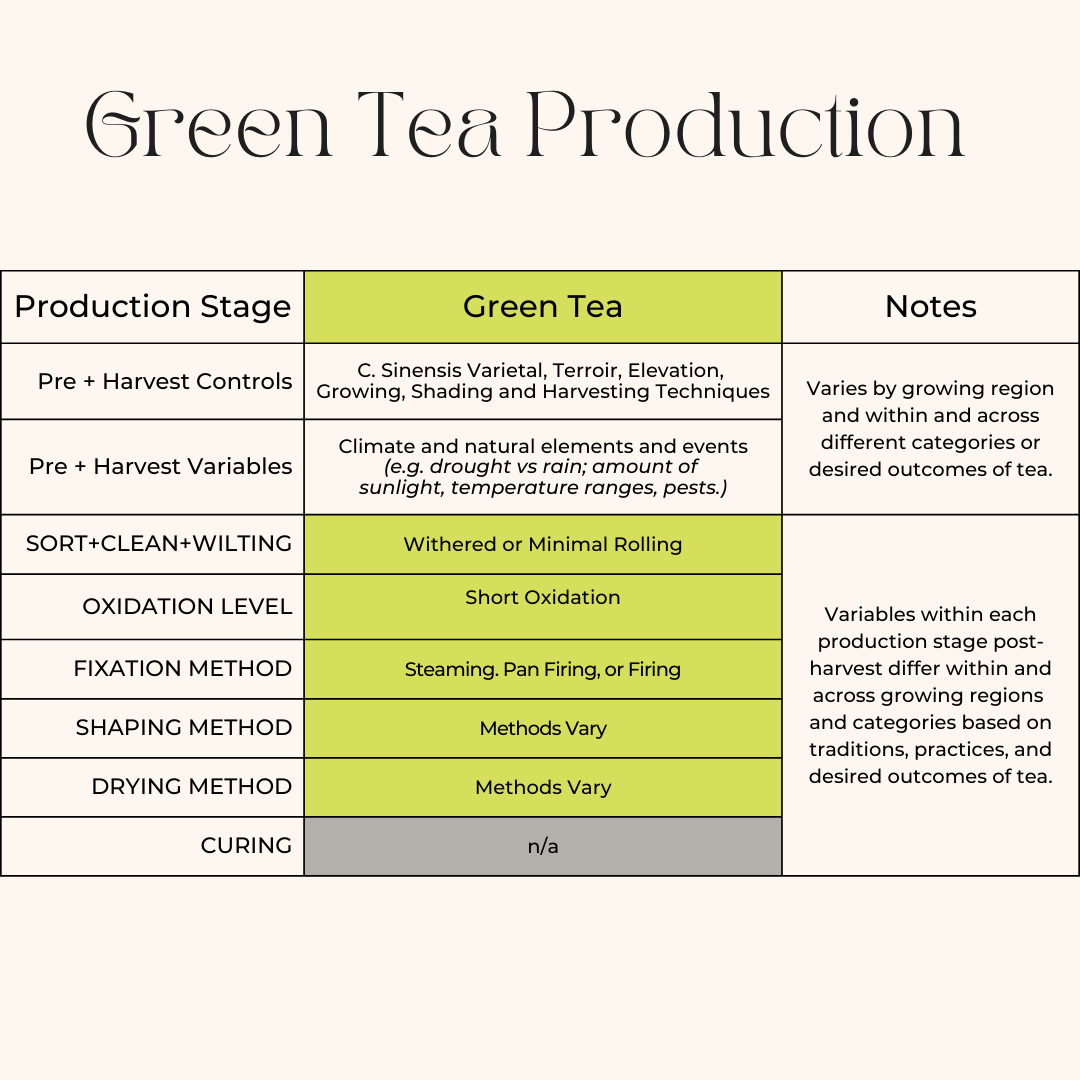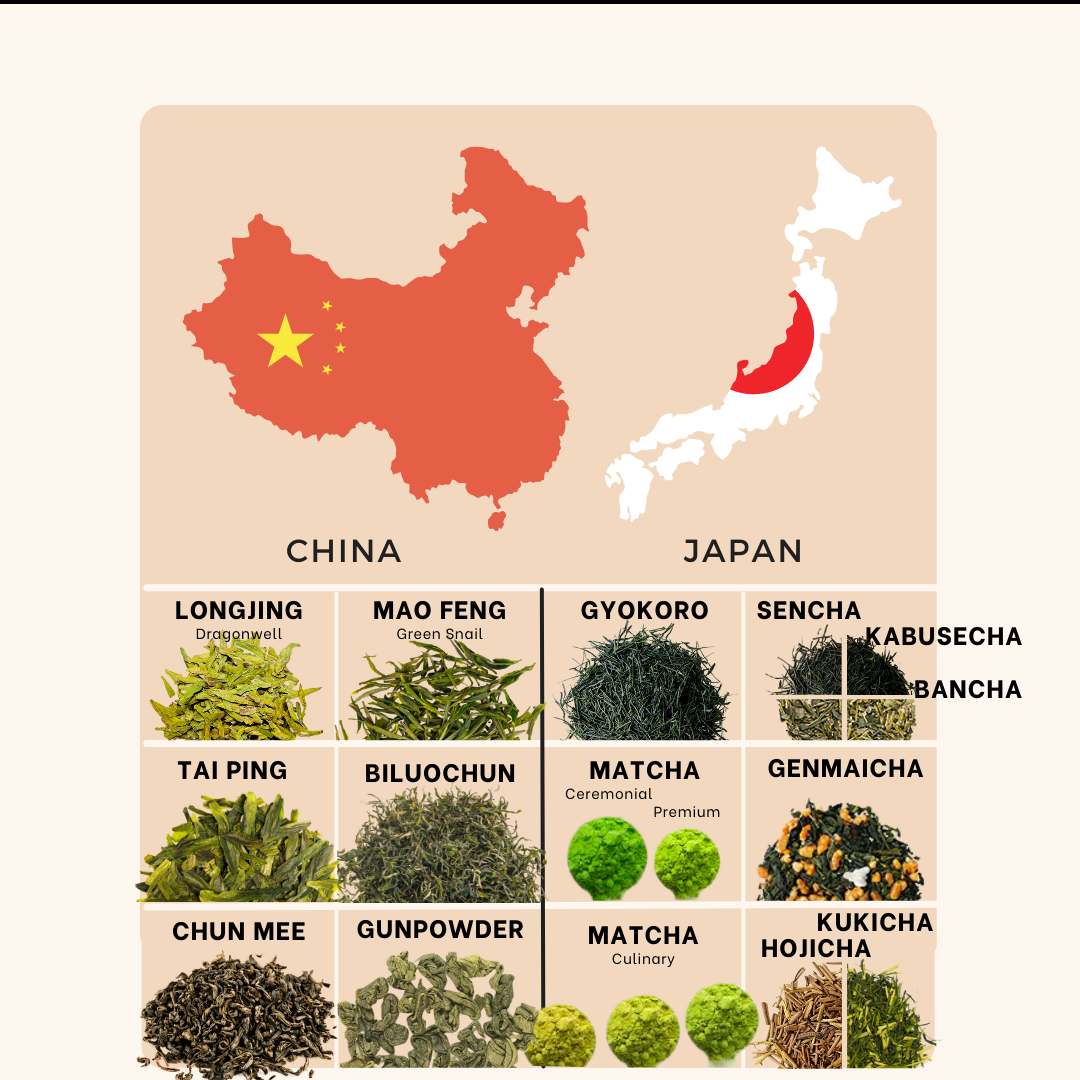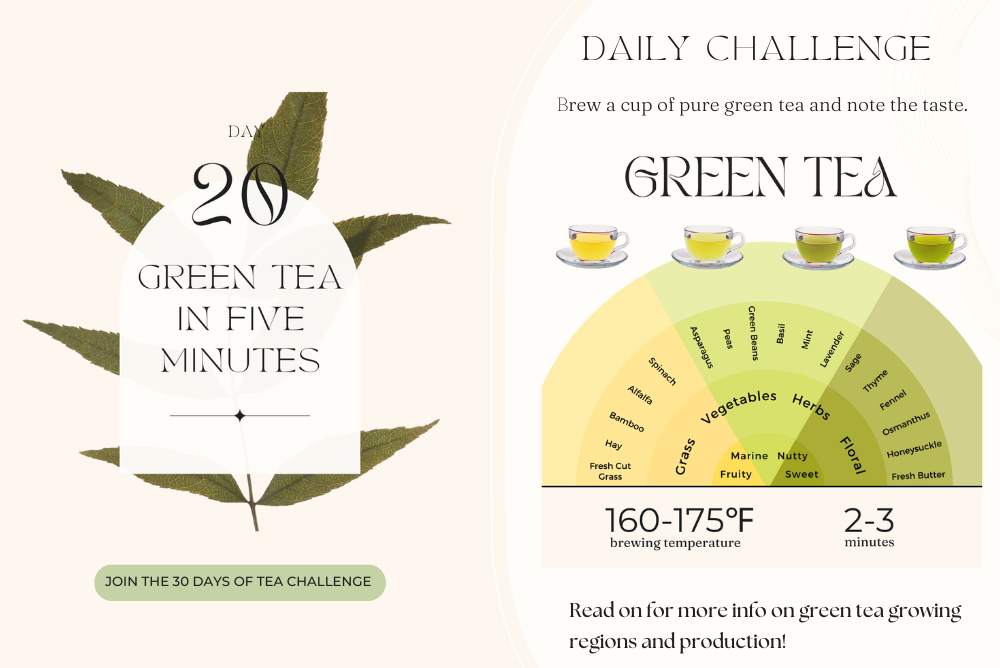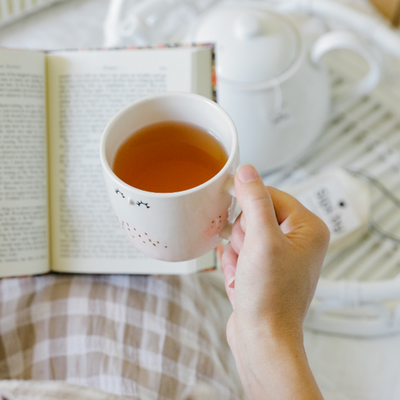Green tea is associated with freshness and purity, a high antioxidant content, and other beneficial properties. Flavors can range from mellow and sweet to vegetal and grassy, with nutty, floral, buttery, roasted, fruity, herbaceous or oceanic notes. Learn more about the ins and outs of green tea, what green tea tastes like, the best green tea brands, and what differentiates it from other types of tea made from the Camellia sinensis plant.
Sips by is a personalized tea discovery subscription. Each month, we match tea drinkers across the U.S. with delicious teas from over 150 global tea brands that we’re sure they’ll love. Members receive 4 teas chosen just for them in every box. Learn more about our tea subscription service.
Shop Best Green Teas
Discover the best green teas as rated by Sips by's 1,000,000 tea-loving Members. From loose leaf green tea to bagged green tea, flavored green tea to unflavored green tea, these are the best green teas from different tea brands around the world. Find your favorite green tea, from matcha to sencha and from pure to flavored, with the caffeine you need to jump start your day. No matter the type of green tea you're searching for, Sips by has options you'll love, whether you love the health benefits of green tea or just love the taste. Discover your new favorite green tea from the best green tea brands today!

History of Green Tea
Green tea originally comes from China, where its methods of production have been refined over centuries. According to legend, green tea was first steeped around 5,000 years ago. Written records note its cultivation and use as a medicine in the Han Dynasty (206-220), but it wasn’t until the Tang Dynasty (618-907) that green tea was consumed for pleasure and had become an integral part of Chinese society. In the 8th century, the process of steaming was developed. Steaming the Camellia sinensis leaves halted oxidation and allowed the leaves to retain their greenness, and also led to the production of better tasting tea. The steamed leaves were crushed to form a paste, and then molded and pressed into cakes and bricks to keep the tea fresh and allow for easier transport. Also around this time, Lu Yu published a famous book called “The Classic of Tea” or “Cha Jing”, which outlined proper techniques for growing, preparing and brewing tea, and helped popularize formalized “tea ceremonies”.
During the Song Dynasty (960-1279), powdered tea (like matcha today!) was invented. After tea plant leaves were picked, they were stored in earthenware jars, and then ground into a fine powder that was to be whisked into a frothy suspension with hot water. Since this way of making tea was labor intensive and expensive, powdered tea could alternatively be made by grinding brick tea. Loose tea as we know it today didn’t rise to popularity until late in the Song Dynasty; however, its taste was quite bitter until the process of pan firing tea was discovered during the Yuan Dynasty (1280-1368). Pan firing to de-enzyme the Camellia sinensis tea leaves drastically changed the flavor profiles of loose leaf tea, which became much more enjoyable to Chinese consumers. The only challenge was that green tea didn’t travel well and it spoiled quickly, so producers in each area of China developed leaf styles and flavors that became characteristic to that region.
When a Japanese monk named Eisai traveled to China to study Buddhism in the 12th century, he was profoundly influenced by the customs of tea drinking that he discovered there and the beneficial effect it had on monks’ focus and concentration during meditation rituals – he published a book in 1214 about the health-promoting and life-balancing qualities of tea, and also brought back tea plant seeds that he propagated, sparking the spread of tea production in Japan. Tea in Japan was commonly prepared as whisked powdered green tea (matcha), which still is popular today in Chado (the Way of Tea) ceremonies. It was not until the late 16th century that loose leaf tea made its way to Japan. To this day, China and Japan are the main producers of green tea; Chinese green tea is distinguished by the pan-firing process, as opposed to the steaming process done in Japan.
Green Tea Processing
A brewed green tea is typically a shade of green, yellow or light brown in color, and common descriptors for good quality green teas can include: grassy, toasty, vegetal, sweet, nutty, floral, buttery, oceanic and umami. The leaf itself as well as the processing method contributes to the resulting flavor. Raw leaf material varies greatly depending on multiple factors, such as the harvest time, weather or climate, cultivar and plucking order.
The traditional method of processing green tea may involve withering, heating, shaping and drying the leaves. Fine green teas are generally composed of “two leaves and a bud” as the standard plucking combination, although some of the finest teas use one bud, or one leaf and one bud. The way green teas are processed is one of the main differences between black tea and green tea.
Japanese green teas are steamed shortly after they are plucked – this process is called de-enzyming because the application of heat kills the enzymes that trigger oxidation.
Chinese teas may go through a withering stage first - after plucking (by hand or with machines), the leaves are spread out and exposed to sunlight or warmth for a few hours. Green tea withering is done in a way to allow the necessary physical wither (reduction in moisture content), while minimizing the chemical wither (oxidation). The common de-enzyming step for Chinese green teas is pan firing: the leaves may be tossed in hot pans until the enzymes are neutralized, or they may be heated and crushed in a rotating machine to simultaneously release and deactivate enzymes.
The tea may then be shaped, either by hand or with machine rollers (this could also occur simultaneously with the first pan firing). Most pan fired tea undergo a final firing to reduce moisture content further, allowing the leaves to be stored without going bad. The tea may pick up slight smokiness or toasted flavor at this point.

Health Benefits of Green Tea
What Can Green Tea Do for You?
Green tea is packed with unique health benefits. Green tea contains the highest levels of powerful antioxidants in the form of EGCG. EGCG is a group of polyphenols that help limit free radical damage to the cells in your body and reduce inflammation. It is also believed that green tea improves blood flow and lowers cholesterol. Several studies conclude that green tea was helpful in the prevention of many cardiovascular conditions including heart disease, high cholesterol, or stroke.
Catechins in green tea also benefit oral health by potentially reducing plaque build-up, bacteria, and bad breath. Some studies also show that it can boost your metabolism and increase the body’s rate of fat oxidation. These potential health benefits combined with the smaller doses of caffeine make green tea one of the healthiest types of tea.
What works well for your heart can also benefit your brain! The caffeine content in green tea isn’t necessarily negative. Green tea contains significantly less caffeine than coffee, similar to other types of tea like black tea. This means that some benefits of green tea include effectively blocking adenosine receptors. By blocking adenosine, your brain feels more awake and cognitive function increases. You’ll get a boost of clarity, focus, increased memory and concentration instead of jitters and an afternoon crash.
In conjunction with this caffeine stimulant, other benefits of green tea include natural levels of the amino acid L-theanine which is a key active ingredient in tea that reduces stress by having a calming effect on the body. However, it’s important to realize that this brain function and mood boost is temporary and does not replace the restorative rest of a good night’s sleep. For days when you didn’t get your 8+ hours of beauty sleep, treat yourself to a glowing cup of green tea or a green tea shot and a green tea for puffy eyes and green tea toner self-care routine.
Types of Green Tea
There is a wide range of green teas out there – if you think you don’t like a particular green tea, you may have tried a green tea type that wasn't for you, had a low-quality green tea, or a green tea that was steeped incorrectly. There is a wide range of green tea types that depend on cultivation practices, terroir or growing environment, part of the plant used, time of harvest, processing method used, and more. The most popular green tea types come from China and Japan as they dominate green tea production – here are a few examples from each country.

China
Green teas are the classic loose leaf teas of China. Today, China sets the standard for pan-fired green teas, and there are a variety of different leaf styles – more so than any other tea category. Leaf styles of Chinese green teas include flat and straight, curly, balled, and twisted. Some popular pan fired Chinese green teas include:
- DRAGONWELL (LONGJING): A famous green tea from China’s West Lake (Xihu) region of Zhejiang province, with a characteristic smooth, flat, sword-shaped appearance and pan-fired toasty taste. It is considered a classic pan-fired Chinese green tea. Premium first-flush Dragonwell is plucked within a 10-day span around early April.
- GUNPOWDER: A well-known green tea that may have gotten its name because the tea resembles gunpowder pellets used for cannons. Its leaves are tightly rolled into balls – the tight roll makes them more durable and able to retain more flavor and aroma while traveling or being stored for lengths of time.
- BI LUO CHUN: Translated as “green spring snail,” a classic green tea from Jiangsu province hand-rolled into tiny spirals, which unfold gracefully in the cup to produce a delicate infusion.
- CLOUD & MIST (YUN WU): Harvested in the mist shrouded peaks of Mount Lu (Lu Shan) from late April to early May. The cool mist allows the tea plants to maintain a deep green color and develop a full buttery and vegetal flavor.
Try more Chinese green teas with your own Sips by Box.



Left: Dragonwell | Middle: Cloud & Mist | Right: Gunpowder
Japan
Japanese green teas are generally steamed, instead of being pan-fired, and can be divided into two overarching categories – sun-grown and shade-grown.
SUN-GROWN
- SENCHA: Translated roughly as “infused tea,” Sencha is the most common green tea produced and consumed in Japan. It refers to teas produced in the spring harvest including two leaves and a bud. During the sorting stage of production, more finely twisted leaves are selected as sencha leaves, and everything else (coarser leaves and stems) is known as bancha. Want a taste of this Japanese green tea? Check out this Saffron Sencha Tea by Tahmina.
- HOJICHA: Produced by roasting bancha (see above) over high heat, giving the leaves a brownish color and the infused tea a rich savory, toasty aroma. It contains very little caffeine and bitterness due to the roasting process.
- GENMAICHA: A blend of bancha or sencha and roasted or popped rice – it is a popular drunk in Japan and the US, commonly paired with foods because of its toasty rice flavor. When matcha is added to it, it is called genmaimatcha.
- KUKICHA: Known as twig tea or stalk tea, it consists of a blend of leaves and stems that are normally left over when producing sencha or gyokuro. Kukicha is generally light and refreshing with a mild sweetness. It is usually a bit lower in caffeine and makes a great iced tea.
Try more sun-grown green teas with your own Sips by Box.



Left: Sencha | Middle: Kukicha | Right: Genmaicha
SHADE-GROWN
- GYOKURO: Translated as “precious dew,” gyokuro is Japan’s highest quality, most sought-after green tea. It is carefully covered with canopies, traditionally made from bamboo, to keep most of the sunlight from reaching the plants. This shading process develops a unique umami flavor and increases L-theanine, chlorophyll, and caffeine levels. Gyokuro is harvested only once a year in early spring – typically in early May – and is carefully plucked by hand.
- KABUSECHA: Sometimes referred to as “shade-grown sencha”, kabusecha is partially-shaded, for less time before harvest than gyokuro. It is a steamed tea in between sencha and gyokuro in terms of flavor profile, as it is neither fully sun-grown nor fully shade-grown.
- MATCHA: Matcha is shade-grown, similar to gyokuro, but it’s unique in that the leaves are stone-ground into a fine powder, to be whisked and suspended into water, instead of infused. Matcha is key in the Japanese tea ceremony, and you’ll find it nowadays as a common cooking ingredient and in lattes. Matcha may be the most potent tea in terms of caffeine and nutrient content, since the whole leaf is consumed, instead of just the infusion. You can get various grades of matcha – ceremonial grade is the most vibrant green and meant to be drunk alone, with low bitterness and a fresh, grassy flavor, while latte/cooking grade is more bitter and is ideal for cooking or mixing with milk or other ingredients.
Try more shade-grown green teas with your own Sips by Box.



Pictured: Gyokuro by Yunomi (left), Kabusecha by Yunomi (middle), Matcha by Zhi Tea (right)
Best Flavored Green Tea
You can find a wide range of green teas that have been scented, blended, or flavored with other ingredients. Here are a few of the most common ones:
- JASMINE GREEN: Jasmine is one of the most popular and widely recognized scented teas in the world. Jasmine green tea is naturally sweet and floral – it is commonly drunk with meals in China. During summer months, jasmine buds are hand-plucked each day in early evening when they are just about to bloom. The jasmine buds are stored overnight with green tea leaves (the tea and flowers are either blended together or placed in alternating layers) – as the buds open in the cool night air, they release an intoxicating aroma that is absorbed by the green tea leaves. Jasmine Green Tea typically looks like any other loose leaf green tea, but you can also find Jasmine Dragon Pearls, which are made from the highest quality tippy leaf and buds, hand rolled into tight pearls and usually scented multiple times with jasmine or rolled with jasmine blossoms. This tea can be steeped multiple times as the pearls unravel more each time, revealing delicious complex flavor notes. We recommend this Organic Jasmine Green Tea by Shangri La Teas.
- MOROCCAN MINT: Moroccan Mint is a traditional drink in Morocco made from Chinese Gunpowder Green tea, fresh mint leaves, boiling water and large amounts of sugar. Today, it's common to find Moroccan Mint blends that use dried mint leaves instead of fresh, and other types of green tea may be used as well. Check out this Moroccan Mint Green Tea by Stash Tea.
Try more flavored green teas with your own Sips by Box.
What Does Green Tea Taste Like?
Green tea has one of the widest flavor profiles out of any tea. Good quality green teas are often described as grassy, toasty, vegetal, sweet, nutty, floral, buttery, oceanic and umami. When tasting green teas, it helps to have an idea of where the tea comes from and how it was grown and processed. For example, we would expect a pan-fired Chinese tea like Dragonwell to have a toasty flavor, while we would expect a steamed Japanese tea like Sencha to have a grassier, more vegetal flavor.
Drinking Green Tea
Do you want to know how to make green tea taste good? When you're drinking green tea, if you've always thought it tastes too bitter, burnt, or flavorless you've probably only had green teas brewed incorrectly. To make green tea taste better, remember to steep green tea using a lower temperature than most other tea types, and brew for a shorter time to avoid bitterness. A delicious way to avoid over-steeping and experience the true flavor of a green tea is to cold brew green tea in the fridge.
Green tea also tastes good with add-ins like sugar, honey, maple syrup, lemon, or splashes of fruit juice like cranberry or pomegranate. Unless you’re drinking a matcha latte, iced and hot green teas are usually too light and delicate for heavy additions, so you wouldn’t put milk in green tea like you would with black tea. Also, green tea is surprisingly delicious to cook with and make tea-infused cocktails! We recommend this making this Green Tea Chicken Soup for a comforting, easy dinner and a glass or two of this Green Tea Ginger Sour or White Peach Green Tea Bellini as an apertif!
When to Drink Green Tea
Several factors determine caffeine levels of any tea, including the plant variety and region it was grown, processing style and brewing method. A common misconception is that green tea is naturally caffeine-free, and green tea does contain lower levels of caffeine than most other teas but it's still an effective morning or afternoon pick-me-up. While black tea contains half as much caffeine compared to coffee, a cup of green tea normally contains half as much caffeine as black tea. A typical 8 oz. cup of green tea will contain 28 milligrams of caffeine, but these levels can range from 11-47 milligrams of caffeine.
Hojicha and Kukicha have some of the lowest caffeine levels of any green tea, because Hojicha uses older tea leaves that undergo roasting in high heat, and Kukicha contains many stems and stalks, which are lower in caffeine than the leaf. On the other side, shaded teas like matcha and gyokuro may contain higher levels of caffeine due to restrictions from sunlight. Studies suggest that their simultaneous higher levels of L-theanine may reduce the effect of caffeine in our systems and lead to relaxation, mental alertness, and reduced stress.
We recommend drinking green tea in the morning, around 30 minutes before or after meals, or before a workout. You can drink green tea at night, but make sure it’s a very low-caffeine green tea or a decaffeinated blend.
How to Store Green Tea
Green tea is the most challenging to keep fresh because it can go stale and lose its flavor more quickly than other teas. Green tea should be consumed within 6 months to a year of purchase (from the best green tea brands it will be relatively fresh when you buy it) for the best taste. You should store your tea in a cool, dark place, away from moisture and strong smells, ideally in an airtight container or sealed package so it doesn't expire. If you have a fresh green tea, especially Japanese teas like matcha or gyokuro, that you don’t plan to consume in the near future you may want to consider storing them in the fridge or freezer in a sealed container to block any food aromas.
How to Brew Green Tea
Green tea is one of the most difficult tea types to brew correctly. Certain types require very low temperatures and steep times – or else they will go bitter and will not be pleasant to drink. It’s best to look on the tea package for brewing instructions specific to your green tea type, but here are a few general guidelines to help you steep a delicious cup!
Preparing Green Tea
WHAT YOU'LL NEED
- Kettle or pot to heat water
- Green tea leaves, sachets, or tea bags
- Teapot with filter, teacup, or your favorite mug with an infuser
STEP ONE: HEAT THE WATER
- 140℉-180℉ // Below boiling
The exact temperature depends on the specific type of green tea (Japanese and first flush teas are generally 160-170℉ and Chinese teas are generally 170-180℉. Gyokuro, a high-grade spring-picked Japanese tea, is brewed at the lowest temperatures of around 140℉)
Pro Tip: If you don’t have a way of setting the temperature on your method of boiling water, bring the water to a soft boil (tiny bubbles) and then allow it to cool down or transfer into another pitcher before pouring into your tea. Never use boiling water for green tea!
STEP TWO: MEASURE THE TEA
- About 2 grams per 8 oz. (1 cup) of water
Pro Tip: Add green tea leaves to an infuser that lets them open fully, or you can put them straight into the teapot and use a strainer when you're pouring a cup.
STEP THREE: STEEP THE TEA
- 30-60 seconds for delicate, spring harvest teas; 1-3 minutes for regular harvest, more robust teas (when in doubt, taste the tea every 30 sec to decide when it’s ready). High quality green teas may be steeped multiple times.
Pro Tip: Don't let your tea steep for too long! Use a tea filters to easily take the leaves/sachet/bag out when the time's up so you aren't left with a bitter cup. Taste your tea after the recommended steeping time and then decide if you’d like it to steep a little longer.
Pro Tip: Cover your tea while it steeps to keep all the heat and aroma in the steeping vessel.
STEP FOUR: ENJOY :)
When steeped, green tea is usually a shade of green, yellow or light brown in color. The flavor of most green tea is light and delicate, so milk is not traditionally added but a squeeze of lemon, sweetener, or drop of honey can bring out the complex flavors of your green tea!
Note: Cold brewing is another way to bring out the sweeter flavors of green tea and avoid bitterness from over-steeping. Or, if you accidentally oversteep hot green tea, just turn it into iced tea to mellow out the flavor!
Want to learn how to steep other types of tea perfectly? Check out our how to make loose leaf tea guide that covers all types of tea!
* These statements have not been evaluated by the Food and Drug Administration. These products are not intended to diagnose, treat, cure, or prevent any disease.
Interested in trying these teas and others? Subscribers receive 4 teas chosen just for them in every box. Learn more about our tea subscription box or explore the loose leaf tea shop.
Our mission at Sips by is to make quality tea fun, personalized, and affordable for the U.S. Click below to create a free tea profile and stay up to date on new tea lessons, learn about healthy tea recipes, and gain access to special brand offers & giveaways!
About Sips by: We’re a female-founded and led startup that makes discovering tea fun, personalized, and affordable. The Sips by Box is the only multi-brand, personalized tea subscription box. Each month, we match tea drinkers across the U.S. with delicious teas from over 150 global tea brands that we’re sure they’ll love. Based out of Austin, Texas, we are adept at savoring a hot mug even when it’s seasonally inappropriate.



